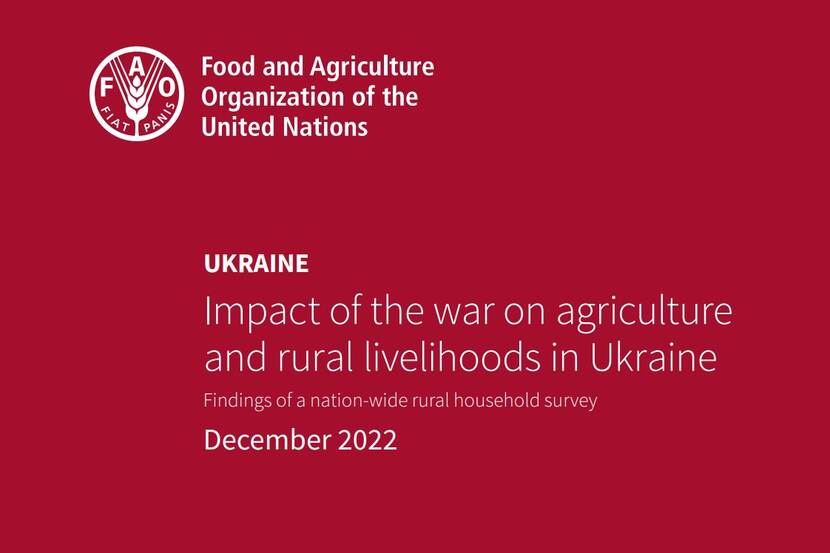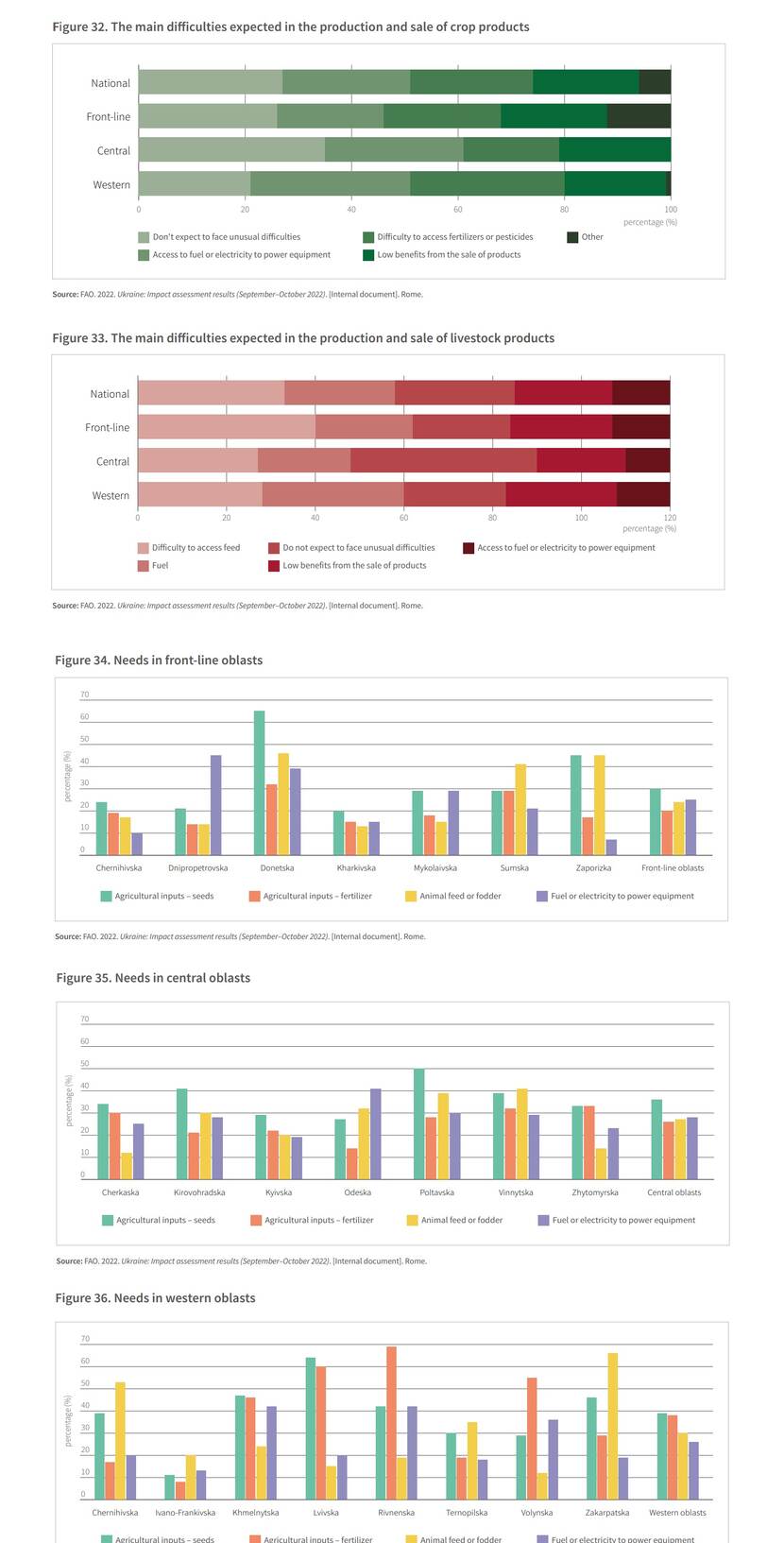Impact of the war on agriculture and rural livelihoods in Ukraine
Findings of a nation-wide rural household survey
FAO, December 2022

The survey can be downoaded from the site of FAO: https://www.fao.org/3/cc3311en/cc3311en.pdf
Assistance and needs
The war in Ukraine has severely affected livelihoods and households’ access to basic services and needs. This alarming humanitarian situation has led the government and other partners to initiate assistance activities mainly in the areas along the front-line oblasts.
At the national level, the major difficulties expected by the rural households involved in production and sale of crop products are: access to fuel or electricity to power equipment (for over 24 percent of the respondents), access to fertilizers or pesticides (nearly 23 percent), low benefits from sale of products (around 20 percent), and access to seeds (18 percent). For oblasts along the front-line, the major difficulty to be expected in the next few months is access to seeds (over 22 percent of the respondents), while in western and central regions around one third of the respondents reported difficulties in accessing fertilizers/pesticides and fuel/electricity to power equipment.
In terms of production and sale of livestock products, nationally, over 30 percent of the rural households expected difficulties in accessing animal feed, around 25 percent mentioned fuel, and slightly over 20 percent mentioned low benefits from the sale of products. When looking at the oblast level, it is observed that almost 70 percent of the respondents in Donetska expected difficulties in accessing animal feed, followed by Lvivska (58 percent), Odeska (55 percent), Zakarpatska (51 percent) and Sumska (50 percent).
Among the greatest needs, around one in three rural households (34 percent) mentioned access to seeds (cereal/vegetable), while slightly over one in four respondents (26 percent) reported access to fertilizers, animal feed and fuel or electricity to power equipment. Access to seeds was most requested (around 40 percent and above) in Donetska, Khmelnytska, Kirovohradska, Lvivska, Poltavska, Rivnenska, Zakarpatska, and Zaporizka. The type of assistance needs varies depending on the oblast of residence. In the front-line oblasts, Donetska (65 percent) and Zaporizka (45 percent) reported the highest need for access to seeds. Access to electricity appears as an urgent concern mainly in Dnipropetrovska (45 percent) and Donetska (39 percent). In addition, there is a significant need for assistance with feed or fodder in Zaporizka (45 percent) and Sumska (41 percent).
In the central oblasts, access to seeds emerged as the main need for assistance in Poltavska (50 percent) and Kirovohradska (41 percent). Needs in terms of access to feed are mainly reported in Vinnytska (41 percent) while in Odeska, 41 percent of rural households expressed needs for access to fuel or electricity to power equipment.
In the western areas of the country, the need for assistance to access fertilizer was reported by more than half of the households in Rivnenska (69 percent), Volynska (55 percent) and Lvivska (60 percent) oblasts. The need for seed assistance is mainly expressed by rural households in Lvivska (64 percent), Zakarpatska (46 percent) and Khmelnytska (47 percent). In the pastoral domain, two-thirds of the surveyed households in Zakarpatska reported a need for assistance to access livestock feed and fodder.

While the situation in Ukraine remains dynamic and unpredictable, rural households, who contribute to a significant portion of the country’s agricultural production, are increasingly exposed to the consequences of the war which is affecting their productive capacity and their agricultural based livelihoods. As a result, progressive adoption of negative coping strategies has been observed and it is already eroding their resilience.
Rural households rely on diversified but limited agricultural production for their own food consumption as well as for displaced persons in rural areas, who are likely to increase in the near future. Their agricultural production depends on and is integrated into the national market, therefore not protected from the negative effects of the war. Significant increases in production costs for both crop and livestock production, interruption and suspension of agricultural production due to war, and related decreases in income are negatively impacting agricultural livelihoods. In turn, this situation results in the use of Stress, Crisis and Emergency coping strategies which show constrained ability to access essential needs, particularly food, as well as to maintain their productive capacities including inputs, fertilizers, animal feed and veterinary services and to access health services.
The rural households living in oblasts along the front-line areas showed the most concerning findings when compared with households in central and western oblasts. However, it is important to note that the impacts are widely spread across the country with rural households in central and western regions also being increasingly affected. These households are hosting a significant number of displaced people with this trend likely to continue in the coming future with the continuation of military operations as well as the damages to the power supply and strategic infrastructures.
In addition, the connection and interdependence between their livelihoods and the overall agricultural economy leaves them exposed to the broader effects of the war on the agricultural sector as observed by repercussion on the costs of production and incomes. Their constrained production, also affected by limited processing capacity, difficulties in accessing the markets and low revenues from selling products is expected to be further compounded by the winter season, when rural households expect major difficulties in access to fuel or electricity to power agricultural equipment, access to fertilizers or pesticides, low benefits from sale of products, and access to seeds.
With the war likely to continue, the current situation risks remaining or worsen. The upcoming winter season and likely further displacement toward the rural areas, the coping capacities of the rural population are likely to progressively be strained. Although households have reported to receive some kind of aid or assistance in the last three months, in addition to usual pension or benefits, the recorded levels of aid or assistance vary significantly amongst the different oblasts. It is critical to protect those households from further deterioration of their productive capacities which are the basis for their resilience. Support rural households’ food production is a mean to mitigate the negative effects of the war on their food security and livelihoods and improve and maintain rural households’ hosting capacities. Revitalize and sustain local agriculture while integrate it in the small-scale agricultural economy will strengthen and protect rural households’ contribution to the broader agri-food system and enhance the benefits they can access in return. In addition, it is important to continuously monitor the situation while also provide complementary assessments to reach a comprehensive understanding of the impact of the war on the agriculture sector and how the war is affecting the capacity to produce and market products in Ukraine and outside the country.
The survey can be downoaded from the site of FAO: https://www.fao.org/3/cc3311en/cc3311en.pdf